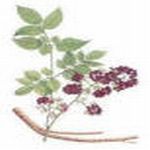| Common Name: |
American Spikenard |
| Other Names: |
Life of man |
| Botanical Name: |
Aralia racemosa |
| Genus: |
Aralia |
| Family: |
Araliaceae |
| Native Location: |
N America. |
| Cultivation: |
Rich, moist soil in partial shade. |
| Propagation: |
By seed sown in spring; by division in spring. |
| Harvest: |
Rootstock is lifted in autumn and dried for use in liquid extracts, decoctions, infusions, powders, and poultices. |
| Height: |
1-2.2m (3-7ft) |
| Width: |
60cm-2m (2-6ft) |
| Hardiness: |
Z3-7 |
| Parts Used: |
Rhizomes, Roots |
| Properties: |
A sweet, pungent, tonic herb that acts as an alterative. It also lowers fever and has diuretic and expectorant effects. |
| Medicinal Uses: |
Internally for bronchial complaints, rheumatic disorders, gout, skin disease, and blood poisoning. Externally for sores and inflammations. Regarded as a rejuvenative in Ayurvedic medicine. |
| Culinary Uses: |
Roots have a licorice flavor, used in root beer Berries are made into jelly. |
| Bibliography: |
Encylopedia of Herbs by Deni Brown Copyright ©: 1995, 2001 Dorling Kindersley Limited pg 126
|

